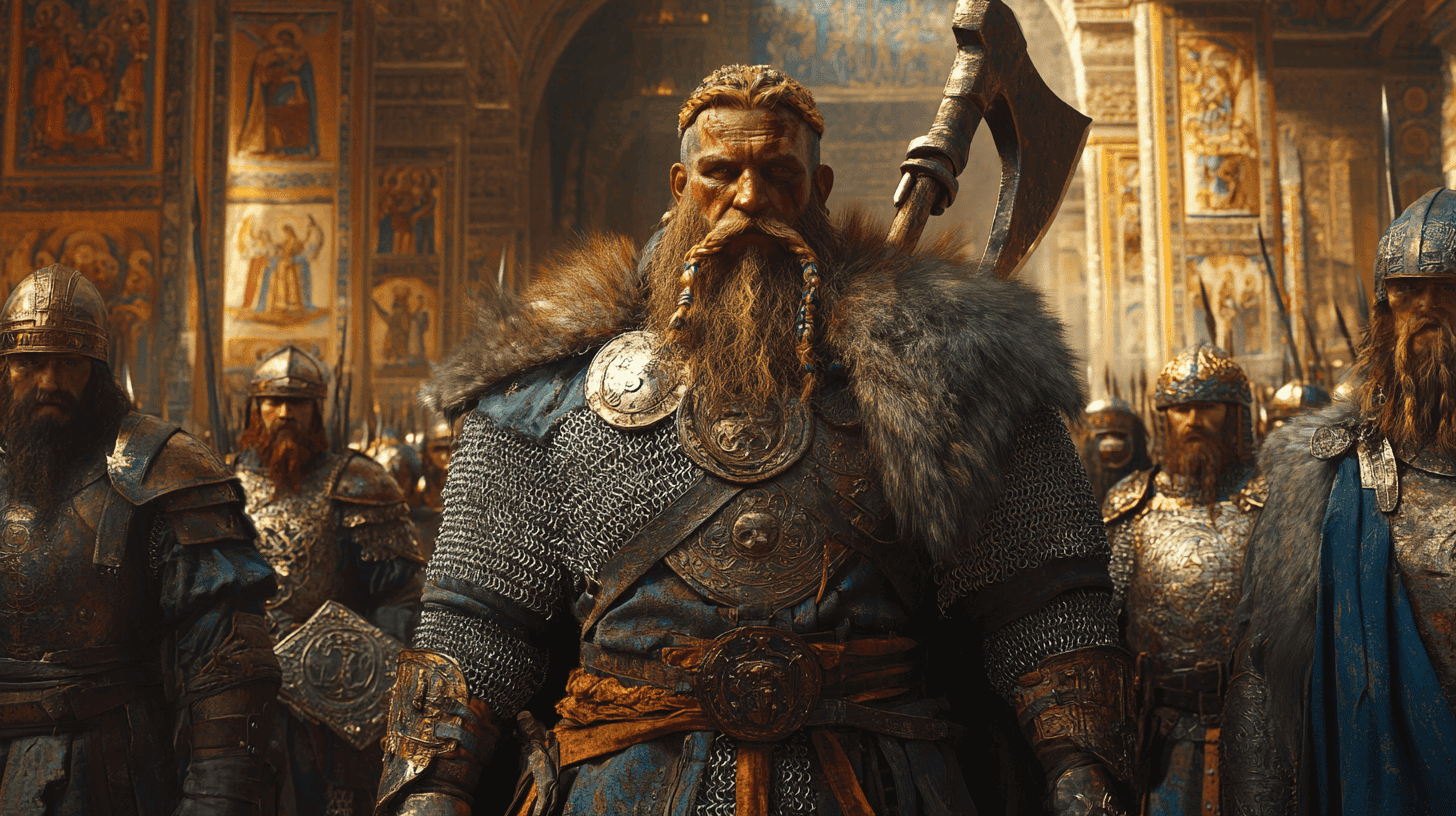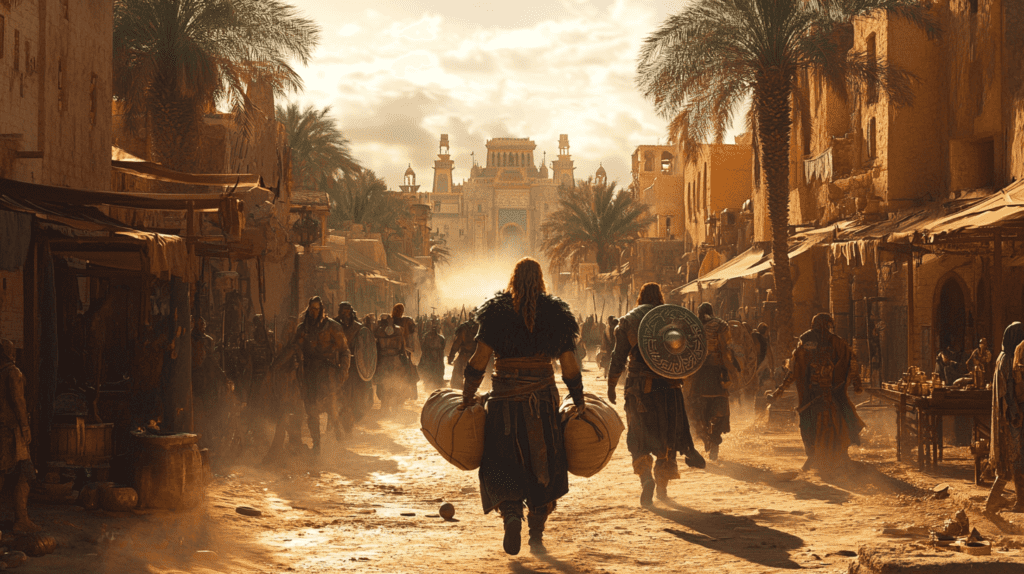
Elite Warriors of the Byzantine Empire
In the annals of military history, few units have captured the imagination quite like the Varangian Guard. These elite warriors, hailing from the cold lands of Scandinavia and later England, served as the personal bodyguards of Byzantine emperors for centuries. Their tale is one of loyalty, martial prowess, and cultural exchange that spans the world from the fjords of Norway to the glittering domes of Constantinople.

Origins of the Varangian Guard
The story of the Varangian Guard begins in the late 10th century, during a time of crisis for the Byzantine Empire. In 988 AD, Emperor Basil II found himself besieged by rebels led by the general Bardas Phokas. With his rule in jeopardy, Basil turned to an unlikely source for aid: Vladimir the Great, the Grand Prince of Kiev.
Vladimir, himself a descendant of Viking rulers, agreed to send 6,000 warriors to assist Basil in exchange for the hand of Basil’s sister Anna in marriage and a promise to convert to Christianity. This agreement not only saved Basil’s throne but also laid the foundation for the Varangian Guard.
The Rus’ warriors who arrived in Constantinople proved to be fierce and loyal fighters. They “cheerfully hacked to pieces” Basil’s enemies, as one chronicler colorfully put it. Impressed by their effectiveness and loyalty, Basil decided to retain these Norsemen as his personal bodyguard, thus formally establishing the Varangian Guard1.

Composition and Recruitment
Initially, the Varangian Guard was composed primarily of Norsemen from Kievan Rus’ and Scandinavia. These warriors, known for their imposing stature and battle prowess, quickly became a feared and respected presence in the Byzantine court.
However, the composition of the guard evolved over time. Following the Norman Conquest of England in 1066, a significant influx of Anglo-Saxons joined the ranks of the Varangians. These displaced warriors, seeking new opportunities after losing their lands to the Normans, found a welcoming home in the Byzantine Empire.
By the late 11th century, under Emperor Alexios Komnenos, the Varangian Guard was largely recruited from Anglo-Saxons and “others who had suffered at the hands of the Vikings and their cousins the Normans”. This shift in composition brought a new dynamic to the guard, blending Norse and Anglo-Saxon martial traditions.
The appeal of service in the Varangian Guard was strong. It offered opportunities for wealth, adventure, and prestige that were hard to come by in their homelands. Many famous figures served in the guard, including Harald Hardrada, who later became King of Norway, and the Icelandic hero Bolli Bollason.

Duties and Responsibilities
The primary duty of the Varangian Guard was to protect the Byzantine Emperor. They formed the “Varangians of the City,” standing sentry at the bronze doors of the Great Palace in Constantinople and guarding the emperor’s properties. Their loyalty and foreign origin made them ideal for this role, as they were less likely to be involved in local political intrigues.
Beyond their role as bodyguards, the Varangians also performed other crucial functions:
Police Duties: They were often tasked with maintaining order in the capital and could arrest high-status individuals due to their imperial authority.
Prison Guards: Varangians frequently operated as jailers, particularly in the dreaded Nóumera prison attached to the Great Palace.
Shock Troops: In battle, the Varangian Guard served as elite shock troops, often leading the charge against enemy forces.
Their versatility made them an invaluable asset to the Byzantine emperors, both in peacetime and during military campaigns.
Combat Prowess and Weaponry
The Varangians were renowned for their ferocity in battle and their distinctive weaponry. Their weapon of choice was the fearsome double-bladed battle-axe, which they wielded with devastating effect. This weapon, combined with their imposing physical presence, made them a terrifying sight on the battlefield.
Michael Psellos, an 11th-century historian, described their arms thus: “These men are, without exception, armed with shields and the rhomphaia, a single-edged sword of heavy iron which they carry on their shoulders”. The rhomphaia was likely a type of long-bladed axe, further emphasizing the Varangians’ preference for heavy, close-combat weapons.
Their effectiveness in battle was legendary. At the Battle of Beroia in 1122, under Emperor John II Komnenos, the Varangian Guard played a crucial role in defeating the Pechenegs. They hacked their way through the enemy’s circle of wagons, collapsing their defensive position and causing a general rout.

Cultural Impact and Legacy
The presence of the Varangian Guard in Constantinople had a significant cultural impact. These Norsemen and Anglo-Saxons brought their traditions, language, and martial culture to the heart of the Byzantine Empire. In turn, they were influenced by Byzantine civilization, creating a unique cultural fusion.
Many Varangians who returned home brought back tales of the wonders of Constantinople, influencing Scandinavian art and literature. The Byzantine Empire also left its mark on Scandinavian culture, with some scholars suggesting that Byzantine influences can be seen in Norse mythology and artwork.
The Varangian Guard’s reputation for loyalty and effectiveness made them a sought-after model for elite units in other medieval kingdoms. Their legacy lived on long after the fall of Constantinople, inspiring stories and legends that continue to captivate historians and enthusiasts to this day.
Famous Varangians
Several notable historical figures served in the Varangian Guard, adding to its mystique and historical significance:
- Harald Hardrada: Perhaps the most famous Varangian, Harald served in the guard from 1034 to 1042 before returning to Norway to become king. His exploits in Byzantine service became legendary.
- Bolli Bollason: This Icelandic hero, mentioned in the Laxdæla saga, served in the Varangian Guard and brought back tales of his adventures to Iceland.
- Georgios Maniakes: While not a Varangian himself, this Byzantine general led Varangian forces in the partial reconquest of Sicily from the Arabs in 1038.
These individuals and others like them helped to spread the fame of the Varangian Guard throughout Europe.
The Varangian Guard in Battle
The Varangian Guard participated in numerous significant battles and campaigns throughout its history. Some of the most notable include:
- Battle of Cannae (1018): A detachment of Varangians helped achieve a decisive victory against the Lombard revolt of Melus of Bari.
- Sicilian Campaign (1038): Under George Maniakes, the Varangians fought alongside Normans and Lombards in the partial reconquest of Sicily from the Arabs.
- Battle of Beroia (1122): The Varangians played a crucial role in defeating the Pechenegs, breaking through their defensive wagon circle.
- Defense of Constantinople (1204): During the Fourth Crusade, the Varangians fought to defend Constantinople from the Crusaders, showcasing their loyalty even in the empire’s darkest hour.
These battles demonstrate the versatility and effectiveness of the Varangian Guard in various military contexts, from siege warfare to open field battles.

The Decline of the Varangian Guard
The Varangian Guard’s influence began to wane in the 13th century, following the sack of Constantinople during the Fourth Crusade in 1204. While they continued to exist in some form, their role became increasingly ceremonial as the Byzantine Empire’s power declined.
The last references to the Varangian Guard date to the 15th century, shortly before the fall of Constantinople to the Ottoman Turks in 1453. Even in the empire’s final days, the deep links between Northern European families and the Byzantine state remained, with English warriors present at the defense of Constantinople against the Turks in 1402.
Conclusion
The Varangian Guard stands as a testament to the complex interplay of cultures and military traditions in Europe. From their origins as Viking mercenaries to their evolution into a multi-ethnic elite force, the Varangians left an indelible mark on Byzantine history.
Their story encompasses themes of loyalty, cultural exchange, and martial prowess that continue to fascinate historians and the public alike. The image of these Norse and Anglo-Saxon warriors, standing guard in the glittering halls of Constantinople, serves as a powerful reminder of the interconnectedness of Dark Age European history.





